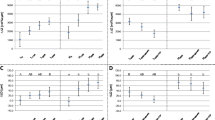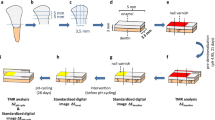Abstract
The aim of this study was to compare the caries-preventive effect of a stabilized stannous fluoride/sodium fluoride dentifrice containing sodium hexametaphosphate with those of a regular, solely sodium fluoride-containing and amine fluoride-containing dentifrice on pre-demineralized bovine enamel specimens using a pH-cycling model. Bovine enamel specimens with two artificial lesions each were prepared. Baseline mineral loss of both lesions was analyzed using transversal microradiography (TMR). Eighty-five specimens with a mean (SD) baseline mineral loss of 3393 (683) vol% × µm were selected and randomly allocated to five groups (n = 13/15). Treatments during pH-cycling (28 days and 2 × 20 min demineralization/day) were: brushing twice daily with slurries of AmF (1400 ppm F−), NaF (1450 ppm F−), SnF2/NaF (1100 ppm F−/350 ppm F−), and fluoride-free (FF) dentifrices or they were immersed in distilled water and remained unbrushed (NB). Subsequently, from each specimen one lesion was covered with acid-resistant varnish, while the remaining lesion was demineralized for another 14 days. Differences in integrated mineral loss (∆∆Z) were calculated between values before and after pH-cycling (∆∆Z E1) as well as before pH-cycling and after second demineralization (∆∆Z E2) using TMR. Treatments AmF and NaF induced a significantly higher mineral gain (∆∆Z E1/∆∆Z E2) compared to treatments FF and NB (p < 0.05; ANOVA test). Except for treatments AmF and NaF no significant differences in mineral loss between before and after pH-cycling could be observed (p < 0.05; t test) [∆∆Z E1: AmF:1563 (767); NaF:1222 (1246); SnF2/NaF:258 (1259); FF:−52 (1223); NB:−151 (834)]. Both dentifrices with either AmF or NaF promoted remineralization, whereas SnF2/NaF dentifrice did not promote remineralization in a biofilm-free pH-cycling model.



Similar content being viewed by others
References
Pessan JP, Toumba KJ, Buzalaf MA. Topical use of fluorides for caries control. Monogr Oral Sci. 2011;22:115–32. doi:10.1159/000325154.
Lippert F. An introduction to toothpaste—its purpose, history and ingredients. Monogr Oral Sci. 2013;23:1–14. doi:10.1159/000350456.
Mellberg JR. Fluoride dentifrices: current status and prospects. Int Dent J. 1991;41(1):9–16.
Dadamio J, Laleman I, Quirynen M. The role of toothpastes in oral malodor management. Monogr Oral Sci. 2013;23:45–60. doi:10.1159/000350472.
Muhler JC, Radike AW. Effect of a dentifrice containing stannous fluoride on dental caries in adults. II. Results at the end of 2 years of unsupervised use. J Am Dent Assoc. 1957;55(2):196–8.
Miller AJ. Oral health of United States adults: the national survey of oral health in D.S. employed adults and seniors: 1985–1986. National findings. National Institutes of Health. 1987;Publication no. NIH-87-2868.
Schiff T, He T, Sagel L, Baker R. Efficacy and safety of a novel stabilized stannous fluoride and sodium hexametaphosphate dentifrice for dentinal hypersensitivity. J Contemp Dent Pract. 2006;7(2):1–8.
Huysmans MC, Jager DH, Ruben JL, Unk DE, Klijn CP, Vieira AM. Reduction of erosive wear in situ by stannous fluoride-containing toothpaste. Caries Res. 2011;45(6):518–23. doi:10.1159/000331391.
Beiswanger BB, Doyle PM, Jackson RD, Mallatt ME, Mau M, Bollmer BW, et al. The clinical effect of dentifrices containing stabilized stannous fluoride on plaque formation and gingivitis—a six-month study with ad libitum brushing. J Clin Dent. 1995;6 Spec No:46–53.
Stookey GK, Mau MS, Isaacs RL, Gonzalez-Gierbolini C, Bartizek RD, Biesbrock AR. The relative anticaries effectiveness of three fluoride-containing dentifrices in Puerto Rico. Caries Res. 2004;38(6):542–50. doi:10.1159/000080584.
Faller RV, Eversole SL, Saunders-Burkhardt K. Protective benefits of a stabilised stannous-containing fluoride dentifrice against erosive acid damage. Int Dent J. 2014;64(Suppl 1):29–34. doi:10.1111/idj.12100.
Ganss C, Lussi A, Grunau O, Klimek J, Schlueter N. Conventional and anti-erosion fluoride toothpastes: effect on enamel erosion and erosion-abrasion. Caries Res. 2011;45(6):581–9. doi:10.1159/000334318.
Schlueter N, Klimek J, Ganss C. Effect of stannous and fluoride concentration in a mouth rinse on erosive tissue loss in enamel in vitro. Arch Oral Biol. 2009;54(5):432–6. doi:10.1016/j.archoralbio.2009.01.019.
Tinanoff N. Review of the antimicrobial action of stannous fluoride. J Clin Dent. 1990;2(1):22–7.
Faller RV, Eversole SL, Yan J. Anticaries potential of a stabilized stannous-containing sodium fluoride dentifrice. Am J Dent. 2010;23 Spec No B:32B–8B.
Lippert F, Newby EE, Lynch RJ, Chauhan VK, Schemehorn BR. Laboratory assessment of the anticaries potential of a new dentifrice. J Clin Dent. 2009;20(2):45–9.
White DJ, Faller RV, Bowman WD. Demineralization and remineralization evaluation techniques—added considerations. J Dent Res. 1992;71 Spec No:929–33.
Arends J, ten Bosch JJ. Demineralization and remineralization evaluation techniques. J Dent Res. 1992;71 Spec No:924–8.
Arends J, Schuthof J, Jongebloed WG. Microhardness indentations on artificial white spot lesions. Caries Res. 1979;13(5):290–7.
Ten Cate JM. In vitro studies on the effects of fluoride on de- and remineralization. J Dent Res. 1990;69: Spec No:614–9 (discussion 34-6).
Buchalla W. Histological and clinical Appearance of Caries. In: Meyer-Lueckel H, Paris S, Ekstrand K, editors. Caries management-science and clinical practice. Stuttgart: Thieme; 2013.
ten Cate JM, Featherstone JD. Mechanistic aspects of the interactions between fluoride and dental enamel. Crit Rev Oral Biol Med. 1991;2(3):283–96.
Tenuta LM, Cury JA. Laboratory and human studies to estimate anticaries efficacy of fluoride toothpastes. Monogr Oral Sci. 2013;23:108–24. doi:10.1159/000350479.
Buskes JA, Christoffersen J, Arends J. Lesion formation and lesion remineralization in enamel under constant composition conditions. A new technique with applications. Caries Res. 1985;19(6):490–6.
Meyer-Lueckel H, Wierichs RJ, Schellwien T, Paris S. Remineralizing efficacy of a CPP-ACP cream on enamel caries lesions in situ. Caries Res. 2015;49(1):56–62. doi:10.1159/000363073.
Esteves-Oliveira M, Pasaporti C, Heussen N, Eduardo CP, Lampert F, Apel C. Rehardening of acid-softened enamel and prevention of enamel softening through CO2 laser irradiation. J Dent. 2011;39(6):414–21. doi:10.1016/j.jdent.2011.03.006.
Cury JA, Francisco SB, Simoes GS, Del Bel Cury AA, Tabchoury CP. Effect of a calcium carbonate-based dentifrice on enamel demineralization in situ. Caries Res. 2003;37(3):194–9.
Arends J, Christoffersen J. Nature and role of loosely bound fluoride in dental caries. J Dent Res. 1990;69 Spec No:601–5 (discussion 34-6).
Amaechi BT, van Loveren C. Fluorides and non-fluoride remineralization systems. Monogr Oral Sci. 2013;23:15–26. doi:10.1159/000350458.
Ellingsen JE. Scanning electron microscope and electron microprobe study of reactions of stannous fluoride and stannous chloride with dental enamel. Scand J Dent Res. 1986;94(4):299–305.
Kondo KY, Buzalaf MA, Manarelli MM, Delbem AC, Pessan JP. Effects of pH and fluoride concentration of dentifrices on fluoride levels in saliva, biofilm, and biofilm fluid in vivo. Clin Oral Investig. 2015;. doi:10.1007/s00784-015-1583-4.
Yamazaki H, Margolis HC. Enhanced enamel remineralization under acidic conditions in vitro. J Dent Res. 2008;87(6):569–74.
ten Cate JM, Buijs MJ, Miller CC, Exterkate RA. Elevated fluoride products enhance remineralization of advanced enamel lesions. J Dent Res. 2008;87(10):943–7.
ten Cate JM, Exterkate RA, Buijs MJ. The relative efficacy of fluoride toothpastes assessed with pH cycling. Caries Res. 2006;40(2):136–41. doi:10.1159/000091060.
ten Cate JM. In situ models, physico-chemical aspects. Adv Dent Res. 1994;8(2):125–33.
Lippert F, Lynch RJ, Eckert GJ, Kelly SA, Hara AT, Zero DT. In situ fluoride response of caries lesions with different mineral distributions at baseline. Caries Res. 2011;45(1):47–55. doi:10.1159/000323846.
Strang R, Damato FA, Creanor SL, Stephen KW. The effect of baseline lesion mineral loss on in situ remineralization. J Dent Res. 1987;66(11):1644–6.
Mellberg JR. Relationship of original mineral loss in caries-like lesions to mineral changes in situ. Short communication. Caries Res. 1991;25(6):459–61.
Schafer F, Raven SJ, Parr TA. The effect of lesion characteristic on remineralization and model sensitivity. J Dent Res. 1992;71 Spec No:811–3.
Thomas RZ, Ruben JL, de Vries J, ten Bosch JJ, Huysmans MC. Transversal wavelength-independent microradiography, a method for monitoring caries lesions over time, validated with transversal microradiography. Caries Res. 2006;40(4):281–91. doi:10.1159/000093186.
Herkstroter FM, Ten Bosch JJ. Wavelength-independent microradiography: a method for non-destructive quantification of enamel and dentin mineral concentrations using polychromatic X-rays. J Dent Res. 1990;69(8):1522–6.
Arndt UW, Creagh DC, Deslattes RD, Hubbell JH, Indelicato P, Kessler Jr. EG et al. Chapter 4.2. International Tables for Crystallography. 2006 p 191–258.
Schlueter N, Hardt M, Lussi A, Engelmann F, Klimek J, Ganss C. Tin-containing fluoride solutions as anti-erosive agents in enamel: an in vitro tin-uptake, tissue-loss, and scanning electron micrograph study. Eur J Oral Sci. 2009;117(4):427–34. doi:10.1111/j.1600-0722.2009.00647.x.
Rolla G, Ellingsen JE. Clinical effects and possible mechanisms of action of stannous fluoride. Int Dent J. 1994;44(1 Suppl 1):99–105.
Acknowledgments
This study was funded by the authors and their institution.
Author information
Authors and Affiliations
Corresponding author
Ethics declarations
Conflict of Interest
The authors declare that they have no conflict of interest.
Additional information
R. J. Wierichs and H. Zelck contributed equally to the study.
Rights and permissions
About this article
Cite this article
Wierichs, R.J., Zelck, H., Doerfer, C.E. et al. Effects of dentifrices differing in fluoride compounds on artificial enamel caries lesions in vitro. Odontology 105, 36–45 (2017). https://doi.org/10.1007/s10266-016-0233-x
Received:
Accepted:
Published:
Issue Date:
DOI: https://doi.org/10.1007/s10266-016-0233-x




